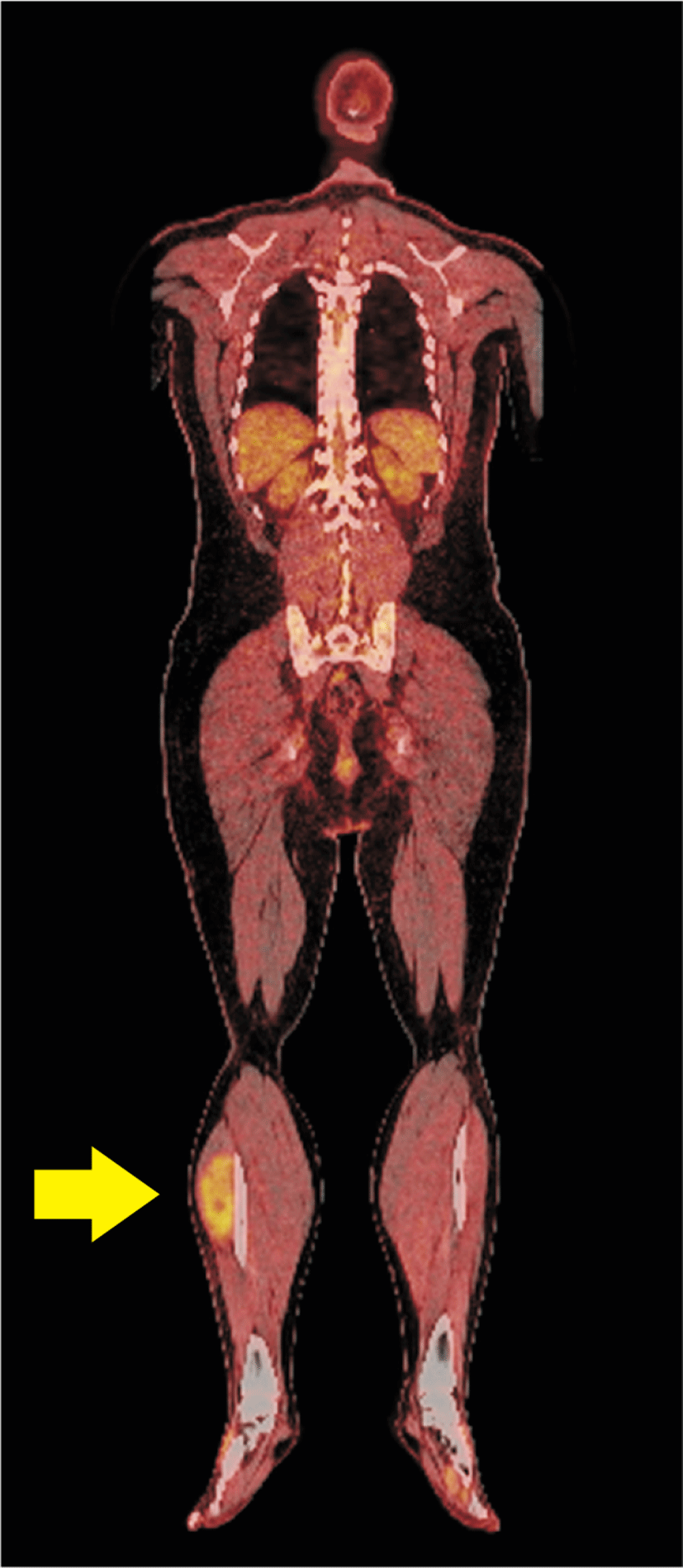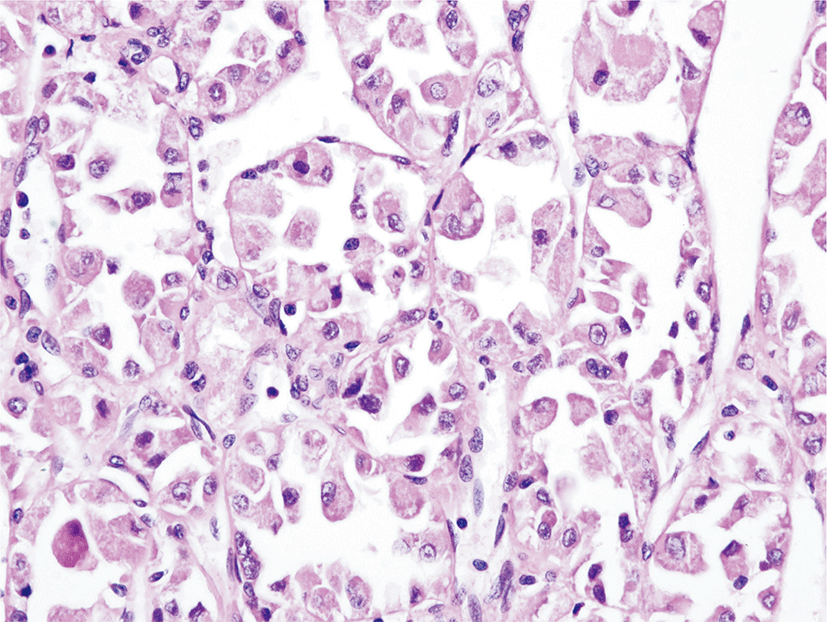Introduction
Alveolar soft part sarcoma (ASPS) is an extremely rare subtype of soft tissue sarcomas in adolescents and young adults. ASPS accounts for approximately 0.5% to 1% of all soft tissue sarcomas, and is observed most commonly in young females [1]. It can occur in any part of the body, especially in the extremities, and frequently metastasizes to the lungs, brain, bone, and lymph nodes [2,3]. Macroscopic finding of ASPS is a yellowish-white round or lobulated soft mass, and microscopic findings are characterized by polygonal cellular, fibromuscular septa, and capillaries-surrounded aveoli-like appearance [3].
The presence of distant metastasis is an important predictor of outcome, which en bloc surgical resection offers the best chance of cure [4], while metastatic disease at the time of diagnosis is associated with poor outcomes and a 20%–46% 5-year survival rate [5].
In addition, ASPS is known to be refractory to chemotherapy and radiation [4]. In a recent phase III randomized controlled study, pazopanib had clinical activity as a single agent in patients with advanced soft tissue sarcoma after failure of standard chemotherapy [6]. This cornerstone study enrolled a broad spectrum of various histology of soft tissue sarcoma.
However, detailed information regarding the response to pazopanib based on different histologies was not available in the final report. Furthermore, there has been no report on the efficacy of pazopanib in patients with ASPS to date. We report a case of ASPS in the right calf and with multiple metastatic lung lesions occurring in a 22-year-old man who showed durable response to pazopanib.
Case
A 22-year-old man complaining of a right calf mass was referred to our hospital in February 2015. He had no past medical history or comorbidity. He was a never-smoker. 18F-fluorodeoxyglucose-positron emission tomography (FDG-PET) showed a hypermetabolic mass in the right calf, measuring 6×4×15 cm (Fig. 1). Multiple variable sized nodules with hypermetabolism were also detected in both lungs by FDG-PET scan. Chest computed tomography (CT) revealed multiple small nodules in both lungs, suggesting metastasis. The needle aspiration biopsy on the right calf mass suggested an ASPS, so he received a surgical resection for confirmatory diagnosis. Histologic features of the specimen showed an alveolar growth pattern outlined by sinusoidal vascular channels and atypical nuclei with prominent nucleoli (Fig. 2). The final pathologic diagnosis from the surgical specimen was ASPS.
After confirmation of diagnosis, the patient was treated with four courses of combination chemotherapy of cytotoxic agents, which were ifosfamide (Union Korea Pharm, Seoul, Korea) 2 g/m2 and adriamycin (Ildong, Seoul, Korea) 20 mg/m2 for 3 consecutive days every 3 weeks. A follow-up chest CT after the completion of 4 courses of cytotoxic doublet revealed increased multiple metastatic nodules in both lungs.
Pazopanib (GSK, Middlesex, UK), a multi-targeted tyrosine kinase inhibitor, 800 mg once daily were administered to the patient as a second line systemic treatment. Significant adverse events except for hair depigmentation were not observed. Laboratory studies during the treatment with pazopanib revealed no abnormal result. Comparing to pretreatment CT scan, a follow-up chest CT scans after 2, 5, and 8 months of pazopanib therapy showed durable response, as multiple small metastatic nodules in both lungs were decreased in size (Fig. 3). In conclusion, pazopanib produced durable responses in this patient with ASPS.
Discussion
ASPS is a very rare soft tissue sarcoma. The frequent primary sites are the extremities, and distant metastasis is often detected at the time of initial diagnosis in most cases [1]. Our patient had a primary tumor at right calf and synchronous multiple lung metastases at diagnosis. The presentation of our case is a typical one considering the previous report that 40% of patients had lung metastases at initial diagnosis [3]. Other frequent metastatic sites in ASPS are the lungs, brain, and bones.
There have been several reports about the prognostic factors in patients with ASPS. The presence of metastasis, tumor size (>5 cm), and bone involvement of primary tumor at the time of diagnosis have been reported to be poor prognostic factors [7]. In our patient, poor prognostic factors were large tumor size and lung metastasis. However, involvement of surrounding bone was not observed.
Local recurrence during follow-up has been reported in up to 20% of patients with localized ASPS [3]. For patients with localized alveolar soft part sarcoma, the excision with microscopically clean surgical margins is critical for a cure. Additionally, adjuvant radiotherapy for patients with inadequate surgical margin is necessary [8]. However, the role of adjuvant chemotherapy in this rare disease is suggested to be ineffective due to the refractoriness to chemotherapy in palliative settings. Anthracycline monotherapy or combination with ifosfamide has been applied for patients with metastatic or unresectable ASPS [9], and the role of any cytotoxic agent has not been proven [4,5]. Although various kinds of targeted agents have been introduced into the field of medical oncology recently, effective targeted therapy has rarely been tried for patients with soft tissue sarcoma due to the rarity of this disease.
A recent first-landmark study was performed as a randomized controlled phase III trial to investigate the role of pazopanib in metastatic soft tissue sarcoma after the failure of first line chemotherapy. This study demonstrated that pazopanib significantly increased progression-free survival compared with placebo in patients with metastatic soft tissue sarcoma [6].
The study excluded not only chemo-sensitive sarcoma like Ewing sarcoma, primitive neuroectodermal tumor, and embryonal rhabdomyosarcoma but also chemo-refractory sarcomas including liposarcoma at enrollment. Although ASPS could be enrolled in this trial, detailed information whether patients with ASPS were enrolled or not, and further whether pazopanib was effective in ASPS patients, and if it was remains missing in the final report of this study. Furthermore, there has been no report or description regarding the clinical treatment experience of an ASPS patient with pazopanib to date.
To the best of our knowledge, this is one of the first reports to describe the clinical efficacy of pazopanib in a patient with ASPS. In this case report, we present the first case of a patient with metastatic ASPS who was treated with pazopanib and showed a durable objective response.
Since pazopanib was already introduced into the clinical practice for patients with metastatic soft tissue sarcoma [10], the information provided by our case report is valuable in terms of applicability in patients with refractory ASPS.
Pazopanib is a multikinase inhibitor that inhibits the major tyrosine kinase receptor activity. It shows highly selective activity against tumor vascular endothelial growth factor receptor, platelet derived growth factor receptor, and c-KIT. Several studies using several tyrosine kinase inhibitors for patients with ASPS have been reported recently. A recent study showed that sunitinib has a demonstrated promising activity in ASPS [11]. Cediranib, a small-molecule inhibitor of all three vascular endothelial growth factor receptors, was also shown to be active in patients with unresectable ASPS [12]. Until now, cediranib is not available in our country and sunitinib is not permitted in sarcoma patient.
As we report the effectiveness of pazopanib in ASPS with metastasis, targeted therapies such as sunitinib and cediranib are anticipated to become promising new strategies in the treatment of ASPS.
As a first active oral agent for patient with ASPS, pazopanib will be a promising new treatment option. To the best of our knowledge, this is a meaningful report of the effectiveness of pazopanib as a second-line chemotherapy in ASPS.


